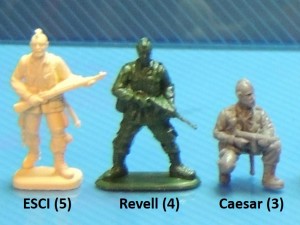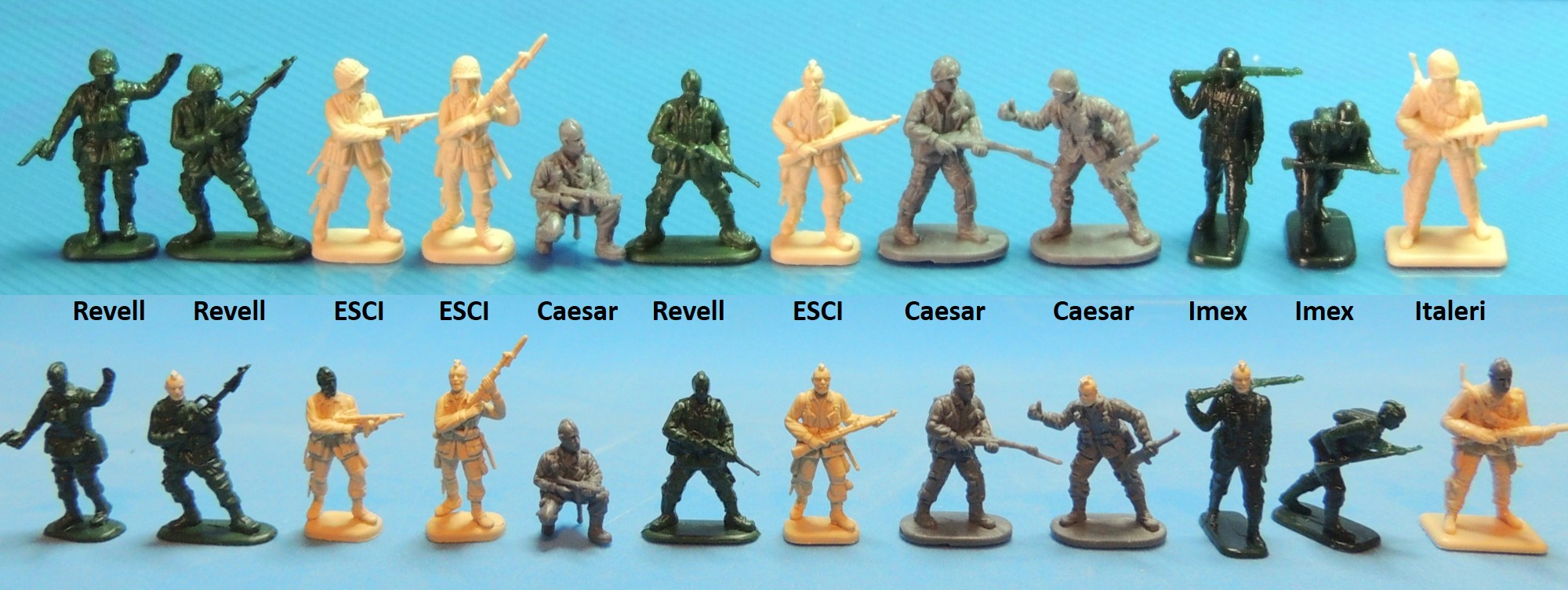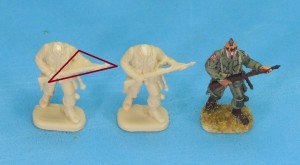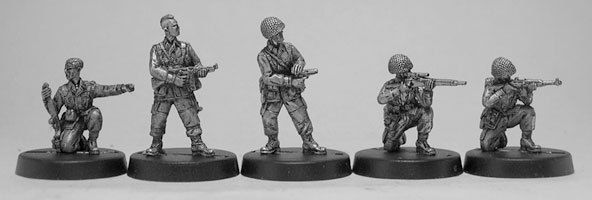This is a follow-up to the previous post, The Filthy Thirteen, Part 1. For a synopsis of these colorful characters, please refer to that post.
It is highly unlikely that any major plastic soldier manufacturer would create a 1/72 scale set of the Filthy Thirteen, as the set would lack wide enough appeal to make it financially viable. While compulsive collectors like me would welcome such figures, the wargamers who currently drive the market would probably not find sufficient uses for them to warrant their purchase. With their distinctive Mohawk haircuts, the only other possible use for such paratrooper figures would be as Pathfinders during the Normandy invasion. Thus, the subject is one more appropriate for the resin or white metal cottage industries.
U.S. Paratroopers in 1/72 Scale
So where are we to find our Filthy Thirteen in 1/72 scale? The group can be created with just a little work. As always, our point of departure is the Plastic Soldier Review (PSR) website to determine the universe of figures available. Six major plastic soldier manufacturers have produced WWII U.S. paratroopers in 1/72 scale, with various levels of success. In chronological order of release they are:
- Airfix 1751 U.S. Paratroops (1975) (14 poses);
- ESCI 209 U.S. Paratroopers “Screaming Eagles” (1983) (14 poses);
- Revell 2517 US Paratroopers (1995) (12 poses);
- Imex 527 Easy Company (2007) (14 poses);
- Italeri 6131 Anti Tank Teams (2009) (4 poses); and
- Caesar H076 US Paratroopers (2012) (11 poses).
Of course, some of these have been re-released by other companies. Please visit the PSR website for an excellent analysis and photos of each of these six sets.
We are fortunate that five of the six sets are excellent, with high PSR ratings in both historical accuracy and sculpting — the two characteristics most important to me. The mediocre 41-year-old Airfix set is the  only exception, lacking sharpness in detail, though still not a bad effort. The ESCI, Revell, and Caesar sets each include one Pathfinder pose, fortunately with 5, 4, and 3 samples in each set, respectively. See photo inset at left. Thus, we have a total of 12 figures: three different ready-made figures and nine extra copies of those figures. To create 12 different figures with Mohawk haircuts, we take the heads of the nine extra copies and transplant them on the torsos of U.S. Airborne figures from the different sets.
only exception, lacking sharpness in detail, though still not a bad effort. The ESCI, Revell, and Caesar sets each include one Pathfinder pose, fortunately with 5, 4, and 3 samples in each set, respectively. See photo inset at left. Thus, we have a total of 12 figures: three different ready-made figures and nine extra copies of those figures. To create 12 different figures with Mohawk haircuts, we take the heads of the nine extra copies and transplant them on the torsos of U.S. Airborne figures from the different sets.
Selecting the Bodies: The Lucky Twelve
The inspiration for this effort was Joel Iskowitz’ painting (see The Filthy Thirteen: Part 1), which depicts most of the Filthy Thirteen without their helmets preparing to board a C-47 Skytrain. Naturally, paratroopers always wore their helmets on their heads in combat, regardless of how sporting their haircuts were. Thus, if our boys were to be shown bareheaded, we needed to use paratroopers not in action. Secondly, paratroopers used a number of different weapons, some of which were specially suited to their jumps. I wanted the set to reflect that variety. I therefore had but two simple criteria for selecting donor bodies: 1) they should not be overtly in action, e.g., aiming their weapons, and 2) they should represent as many of the weapons used by U.S. Airborne troops as possible.
These two parameters greatly limited selection but after careful consideration I judged the twelve figures below — out of a combined total of 69 poses from all six sets — to be least in combat and to represent most of the weapons used by U.S. paratroopers: Every unit needs an officer with a pistol and the Revell figure on the far left best fit the bill, though he’s more animated than I would have preferred. Similarly, every unit has a gentle giant — at least according to Hollywood — and the slightly oversized Italeri figure on the far right met that need. In retrospect, I regret not using at least one Airfix figure so that every figure set was represented. As an aside, one of the Airfix figures is “the spitting image of John Wayne,” according to a 1975 issue of Airfix Magazine — something of a redeeming quality of the Airfix set, at least for me. As a further aside, I’m partial to the Imex set, which, to my eye, looks the most natural and best sculpted. Unfortunately for this project, all its figures are clearly engaged in combat except the two I used.
Every unit needs an officer with a pistol and the Revell figure on the far left best fit the bill, though he’s more animated than I would have preferred. Similarly, every unit has a gentle giant — at least according to Hollywood — and the slightly oversized Italeri figure on the far right met that need. In retrospect, I regret not using at least one Airfix figure so that every figure set was represented. As an aside, one of the Airfix figures is “the spitting image of John Wayne,” according to a 1975 issue of Airfix Magazine — something of a redeeming quality of the Airfix set, at least for me. As a further aside, I’m partial to the Imex set, which, to my eye, looks the most natural and best sculpted. Unfortunately for this project, all its figures are clearly engaged in combat except the two I used.
Transplanting the Heads
Head transplants are fairly straightforward:
- Lop off the helmeted head;
- Drill a hole on the neck of the torso;
- Drill a hole on the base of the donor head;
- Superglue a tiny metal pin in the torso hole; and
- Superglue the donor head in place.
Presto! You’ve got brand new figures. For an excellent, detailed how-to discussion of head-switch conversions, see this Figure Conversion article on the oneseventytwoscale.com website.
The photo below shows the selected figures before and after the head transplant.
Of course, I cleaned up the seams and, where necessary, I removed excess plastic from the figures, particularly where the piece was  blind to the mold, which is common between the midsection of the figure and a weapon when held with both hands. See the excess plastic marked in red in the ESCI figure at left. Though Caesar’s modern multi-mold process allows its sculptors to be adventurous, crafting poses that are more three-dimensional, the downside is that their figures often have excess plastic in these blind spots.
blind to the mold, which is common between the midsection of the figure and a weapon when held with both hands. See the excess plastic marked in red in the ESCI figure at left. Though Caesar’s modern multi-mold process allows its sculptors to be adventurous, crafting poses that are more three-dimensional, the downside is that their figures often have excess plastic in these blind spots.
The Thirteenth Samurai
The title is a thinly veiled reference to Eiichi Kudo’s 1963 film The Thirteen Assassins — one of the best Samurai movies not directed by Akira Kurosawa. (The 2010 remake of this classic is also pretty darn good.) Incidentally, any reader who has not seen Ran, Kurosawa’s 1985 masterpiece, is missing out on the best war movie ever made — bar none — in my not unbiased opinion.

But forgive the digression. As I mentioned, the plastic figure sets yielded a total of 12 Mohawk heads but I still needed one more to complete my devil’s dozen. I decided to use the Pathfinder figure from the TQD-AA5 1944-45 US Airborne white metal set — to my knowledge the only other 1/72 scale Pathfinder figure in production. The photo above is from the TQD website. TQD figures are somewhat more pricey compared to plastic but are generally superb, and this set is no exception: realistic proportions, fine detail, historical accuracy, and metal content, which, unlike plastic, takes paint well.
There they are: 13 U.S. Airborne 1/72 scale figures to represent the Filthy Thirteen. I hope you enjoyed the post. Stay tuned tomorrow for Part 3: Selecting the Weapons, covering the most common weapons used by U.S. paratroopers. As always, comments, questions, corrections, and observations are welcome.

Bob says:
Great articles on the process and the unit. Thanks for sharing.